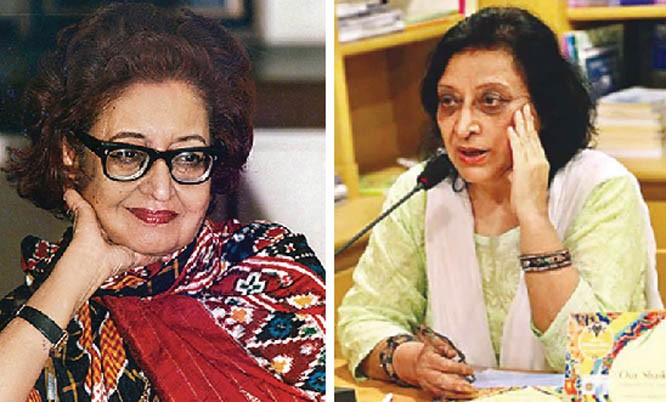
Women writing poetry is a phenomenon that need not only be acknowledged but also examined literarily

The last century saw an increase in the number of women taking an active part in literary discourse, both in Urdu and in other South Asian languages. There were some women poets of renown in medieval and pre-modern eras. Names of Raabia Khuzdari (who flourished in the 10th century) in Balochi, Lal Ded (1320-1392) in Kashmiri and Meera Bai (1498-1546/1547) in Rajasthani come to mind. The history of Urdu literature, however, has not been rich in women poets.
When Dr Rasheed Jahan (1905-1952) contributed to Angaare, a collection of modern short stories in the beginning of the twentieth century, it was an important moment in the history of modern Urdu literature. No wonder Jahan was dubbed as Angaare Waali for being the only woman contributor to the collection that aimed at challenging certain social mores. Jahan, a firebrand and one of the earliest adherents to the progressive writers’ movement is, however, remembered more for the ‘first’ than as a writer of great calibre. Her early demise did not allow the realisation of her true potential. That being said, we must not forget that it was she who started a trend which was subsequently followed by Ismat Chugtai and other women writers of fiction.
Qurratulain Hyder -- who has received much critical acclaim, even if she has not been too popular with the masses -- wrote in a gender-free mode for a long time. Coming from an upper class, feudal household, Hyder wrote mostly about the womenfolk of upper social strata. But, judged solely by literary criteria, Hyder is undoubtedly one of the major fiction writers in the region. Some, like Shamasur Rahman Faruqi, would put her atop the list.
We also have Khaleda Hussain in the short story department who arguably towers above most in the genre, regardless of gender, at least in her generation both in terms of profundity as well and thematic range.
The poetry scene, on the other hand, is not so magnificent. Leaving aside a few instances of women poets in the classical era and some rudimentary endeavours in the early years of twentieth century, Ada Jafri is the first woman poet to be reckoned with - followed by likes of Zohra Nigah, Kishwar Naheed, Fehmida Riaz, Nasreen Anjum Bhatti, Sara Shagufta and Parveen Shakir.
Some might question Parveen Shakir’s making the list as she is generally considered a poet associated with the ‘popular’ stream. It is unfair, however, to think that a poet cannot be both good and popular in her work, she comes out tremendously matured.
Together these poets speak for a strong and self-confident woman who is not only aware of patriarchal regimes but, is also blessed with the guts to brave them. This is not to say that these poets address only the ‘women question’, even if they appear to be writing along the lines.
There is no denying that the literary feminism of the likes of Kishwar Naheed and Fehmida Riaz offers a valuable perspective on many pertinent questions. They depict many chronic problems that have plagued the Pakistani society. Their poetry provides useful references in studies in sociology, cultural anthropology and gender studies.
But, does their poetry stand the test of a close scrutiny, strictly from a literary point of view? Sadly, it does not.
Ask any judicious literary critic to name twelve most important poets in the post-partition Urdu literature. It is hardly likely that the name of any women poet will be included. Is it because of a pervert gender bias in our literary criticism or the overall male hegemony in our culture? If so, why would the same critic not forget mentioning Hyder or Khaleda Hussain if required to name major fiction writers?
Of the poets on the list, Sara Shagufta stands out as a radical voice. In some ways, she comes close to one Fahmida Riaz. Shagufta’s early departure put an end to what might have been a powerful poetic career.
The redeeming grace in the coterie could perhaps be a less well known if much respected Nasreen Anjum Bhatti. Her serene, dense, profound and penetrating poetic style.
A bilingual poet, (Urdu and her mother tongue: Punjabi) Bhatti has written in a vigorous female accent coupled with a heightened sense of political correctness. In her poetry, the persona of a truly creative person transcends both her feminism and politics in such a way as to make her arguably the most important woman ever in both Urdu and Punjabi. Some critics have compared her with a Punjabi poet from India; Amrita Pritam - most probably due to their apparent resemblance in highlighting women issues and political consciousness, and possibly due to exaggerated acclaim that the latter was accorded in the post-partition Punjabi poetry. However, Bhatti’s far wider range and her much deeper poetic experience expressed in her chaste diction have the grandeur of classics quite unlike Pritam’s banal and prosaic verses.
Women writing poetry is a phenomenon that needs not only to be recognised and acknowledged, but it is time that we examined it - literarily. While appreciating the role of women poets one ought to be careful, lest one confuses the mere depiction of issues with poetry.
On listening to painter Degas complaining about his inability to write poems even though "he was full of ideas", Stéphane Mallarmé had famously retorted: "My dear Degas! poems are not made out of ideas. They’re made out of words."
Mallarmé has a valid point - if by words he means poetic core and literary values.